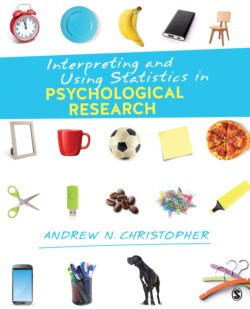Читать книгу Interpreting and Using Statistics in Psychological Research - Andrew N. Christopher - Страница 10
На сайте Литреса книга снята с продажи.
Chapter 1 Why Do I Have to Learn Statistics? The Value of Statistical Thinking in Life
ОглавлениеAfter reading this chapter, you will be able to
Identify reasons why people tend to ignore information about probability in everyday life
Identify reasons why people tend to misunderstand connections between events in everyday life
Differentiate research methods for each of the four goals of research
Differentiate basic concepts in statistical thinking
“Statistical thinking will one day be as necessary a qualification for efficient citizenship as the ability to read and write.”
—H. G. Wells
When I was in high school and college, I took a math-based class (e.g., algebra, geometry, statistics, and calculus) every semester. I did fairly well in these classes because I worked hard and usually earned decent grades, never spectacular but not bad either. Playing around with numbers was a fun intellectual exercise for me back then. During that same time, I took writing-based classes (e.g., composition, creative writing, business communications, and literature). At the risk of being arrogant, I usually earned solid “A”s in those classes (and even some “A+”s because we could get those at my high school). Candidly, I did not work nearly as hard in my writing classes as I did in my math classes. I was by no means a gifted writer, but thanks in large part to my parents, I always understood the importance of writing and communication abilities even when I was in middle school. Indeed, how can good writing and other communication skills do anything but help a person in a job or many other life situations, such as developing personal relationships? I took more writing classes than my high school and college required just because they were so much fun and easy for me. Math classes? Not so much. Until I was in graduate school, I never saw the relevance of math classes outside of the classroom. Then, in my third graduate-level statistics class (yes, you read that correctly, my third graduate-level statistics class), something clicked. Even now, 19 years later, I don’t know what it was that clicked. But something clicked, and I began understanding the relevance of the numbers I was using. When I began to see the logic of each statistic that I was calculating, all I wanted to do was learn more about statistics. And as I did so, I understood the logic of statistics, even fairly high-level statistics, more quickly and became much better able to use such logic not only in research but in “real-life” situations as well.
Photo 1.1 Statistical information is everywhere. Understanding it is essential for success not just in school, but also in life more generally.
Source: ©Bradford Veley/CartoonStock
Maybe I was not very smart in high school or college, but I look back at that time and cannot understand what took me so long to see the logic behind statistics. When I started teaching statistics more than 15 years ago, I swore that my students would leave the class understanding the logic of statistics. Some have gone on and used statistics in research careers; most have not. Those who are not using technical statistics in their work are still dealing with situations that require the same logical thinking that statistics requires. If you are interested in doing research or are already enthusiastic about dealing with quantitative information, you probably don’t need to be sold on the idea that statistics will be important to you. However, before we dive into specific statistical information, I want to take some time to discuss the general importance of statistics, both to researchers and to alike. For those of you taking this class solely because you have to take it, I hope it will give you some idea of why you are here and the benefits you should expect to gain while you are here. It is my hope that by the time you complete this class, you will understand the importance of statistics in making sense of research, in addition to using the logic of statistical thinking in more everyday situations.
In the first part of this chapter, we will discuss why a lot of people are not good at using statistical logic in their daily lives. I do not want you to be like a lot of people in this regard as it can be costly in many ways. We will highlight the reasons most people are not good at dealing with statistical information in daily life and, in doing so, detail some of these everyday situations, describing how statistical logic is (or should be) used in each one. The second section will discuss some basic goals of research and the role that statistics play in achieving each of these goals. Finally, we will introduce some basic statistical information we will see throughout this course and, in doing so, highlight how such information can improve our ability to think about the world.
